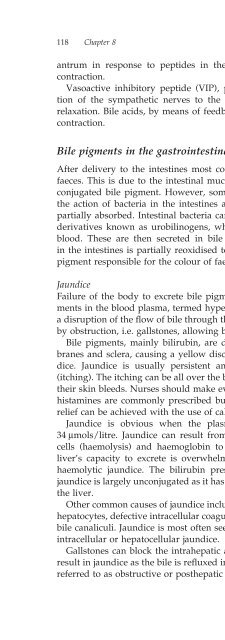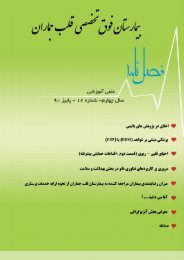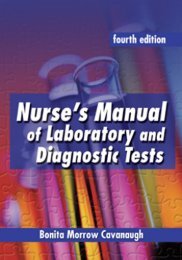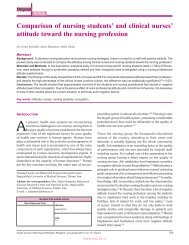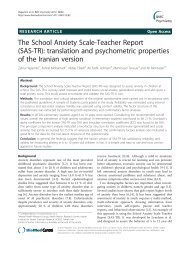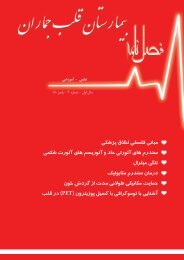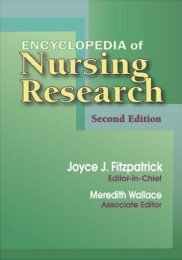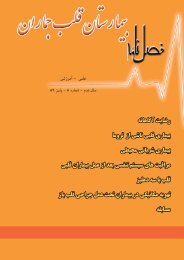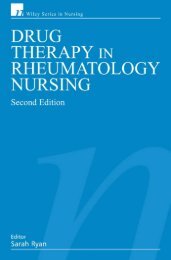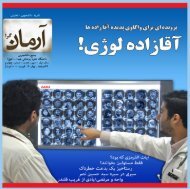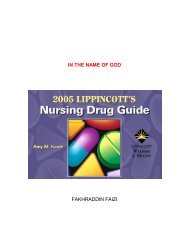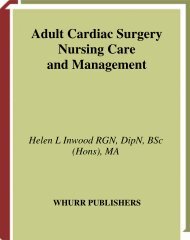Gastrointestinal Nursing.pdf
Gastrointestinal Nursing.pdf
Gastrointestinal Nursing.pdf
You also want an ePaper? Increase the reach of your titles
YUMPU automatically turns print PDFs into web optimized ePapers that Google loves.
118 Chapter 8antrum in response to peptides in the food, also stimulates gall bladdercontraction.Vasoactive inhibitory peptide (VIP), pancreatic polypeptide and stimulationof the sympathetic nerves to the gall bladder, all cause gall bladderrelaxation. Bile acids, by means of feedback control, also inhibit gall bladdercontraction.Bile pigments in the gastrointestinal tractAfter delivery to the intestines most conjugated bilirubin is excreted in thefaeces. This is due to the intestinal mucosa not being very permeable to theconjugated bile pigment. However, some bilirubin may be deconjugated bythe action of bacteria in the intestines and the free bilirubin formed can bepartially absorbed. Intestinal bacteria can also convert bilirubin to colourlessderivatives known as urobilinogens, which can be absorbed into the portalblood. These are then secreted in bile and urine. Urobilinogen remainingin the intestines is partially reoxidised to stercobilinogen, the reddish-brownpigment responsible for the colour of faeces.JaundiceFailure of the body to excrete bile pigments results in accumulation of pigmentsin the blood plasma, termed hyperbilirubinaemia. This can result froma disruption of the flow of bile through the common bile duct or hepatic ductsby obstruction, i.e. gallstones, allowing bile to build up in the blood.Bile pigments, mainly bilirubin, are deposited in the skin, mucous membranesand sclera, causing a yellow discoloration commonly known as jaundice.Jaundice is usually persistent and accompanied by severe pruritus(itching). The itching can be all over the body and the patient can scratch untiltheir skin bleeds. Nurses should make every effort to relieve the itching; antihistaminesare commonly prescribed but these can cause sedation. Effectiverelief can be achieved with the use of calamine lotion.Jaundice is obvious when the plasma bilirubin concentration exceeds34 µmols/litre. Jaundice can result from excessive breakdown of red bloodcells (haemolysis) and haemoglobin to release bilirubin. Consequently theliver’s capacity to excrete is overwhelmed; this is known as prehepatic orhaemolytic jaundice. The bilirubin present in the plasma in this form ofjaundice is largely unconjugated as it has not been taken up and conjugated bythe liver.Other common causes of jaundice include decreased uptake of bilirubin intohepatocytes, defective intracellular coagulation, or disturbed secretion into thebile canaliculi. Jaundice is most often seen in acute hepatitis and is known asintracellular or hepatocellular jaundice.Gallstones can block the intrahepatic and extrahepatic bile ducts. This canresult in jaundice as the bile is refluxed into the blood. This type of jaundice isreferred to as obstructive or posthepatic jaundice.


